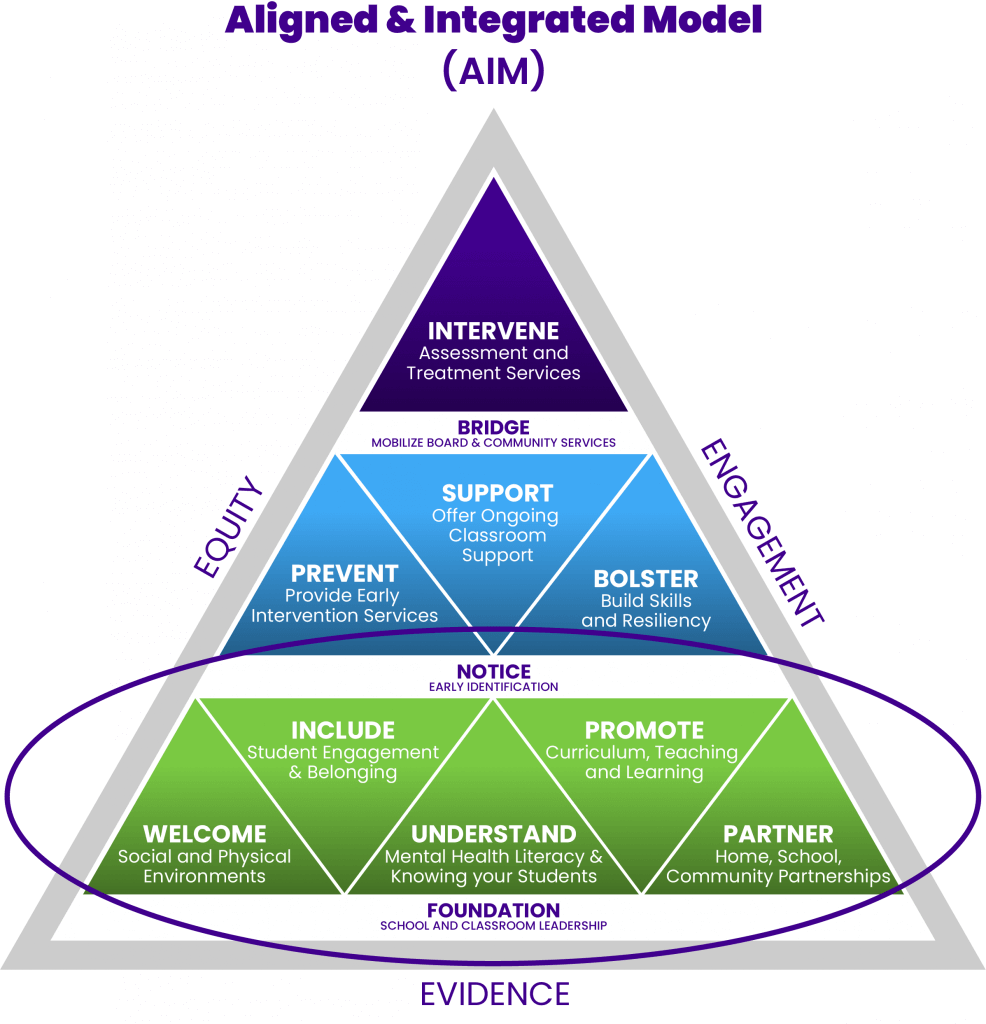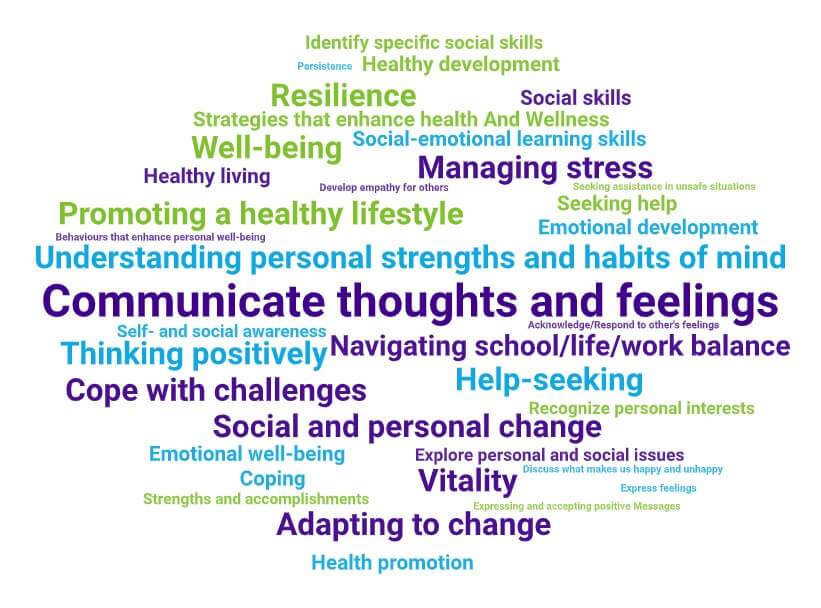Mental health in the classroom – what is the role of an educator?
As educators, we know that our role is to teach curriculum and provide opportunities for students to learn, explore and be curious-but what about mental health? What is the role of educators?
Start with connection and relationship, mental health will follow.
~ Advice to educators from Lillian, Ontario grade 12 student and member of ThriveSMH
What is mental health?
Let’s start by considering what mental health really means – it may not be what you think! Mental health is the state of an individual’s psychological and emotional well-being. It’s a necessary resource for living a healthy life and a main factor in overall health. It does not mean the same thing as mental illness. Good mental health allows us to feel, think and act in ways that help us enjoy life and cope with its challenges. Given this, what does mental health at school look like? Mental health at school can involve both identity-affirming mental health promotion and literacy.

Mental health promotion is the foundational everyday work that educators and school staff do within and beyond the curriculum to welcome and include students, to understand them, to build knowledge of mental health, to promote mentally healthy habits and to partner with families, students and other staff to create a supportive environment (PPM 169).
Mental health literacy includes the knowledge, understanding, skills, and confidence that help us care for our mental health, support others, and know how to seek help, when it’s needed.
Here’s what we use in PPT decks, along with a link to the Our Approach page where we have the accordion with the long description:
The Aligned and Integrated Model or AIM is a triangle that shows the three tiers of student mental health support in Ontario.
Le modèle harmonisé et intégré ou MHI est un triangle qui montre les trois niveaux de soutien pour la santé mentale des élèves en Ontario.
Here’s the original long description from the accordion with the addition of the oval around the first tier:
The Aligned and Integrated Model or AIM is a triangle with three equal sides that shows the three levels of student mental health support in Ontario. The bottom of the triangle is the Foundation and includes school and classroom leadership. It’s divided into the following five sections:
Welcome – school and classroom physical environments
Include – student engagement and belonging
Understand – Mental health literacy and knowing your students
Promote – Curriculum, teaching and learning
Partner – Home, school, community partnerships
An oval around the bottom level of the triangle, known as tier 1, indicates the level where mental health promotion work happens in schools.
The second level is Notice and represents early identification. It’s divided into the following three segments:
Prevent – Provide early intervention services
Support – Offer ongoing classroom support
Bolster – Build skills and resiliency
The third level is the top of the triangle. It is Bridge and represents mobilizing board and community supports. It includes one segment:
Intervene – Assessment and treatment services The words equity, engagement and evidence appear around the graphic.
Why does mental health at school matter?

These words and phrases have been taken directly from Kindergarten to grade 12 curriculum expectations (across a wide variety of courses) as examples of mental health learning happening in Ontario classrooms.
Mental health promotion and literacy that affirms, reflects and celebrates the identity of every student supports students to be well so they can fully engage in school and in life.
There are connections to mental health throughout curriculum from Kindergarten to grade 12. These connections might be new to you, but this teaching isn’t. Educators have been teaching about mental health for years, and they are well positioned to do so.
Learning about mental health is necessary and helpful for students because mental health learning supports ALL learning. It helps students feel prepared to learn, supports a sense of belonging at school, and can improve academic performance, too (PPM 169). Students also tell us that they want this type of learning at school (#HearNowON 2021). It’s relevant for all because we ALL have mental health, and it impacts us no matter our age, grade, community, culture or career path.
The word art graphic shows the following terms:
Communicate thoughts and feelings
Understanding personal strengths and habits of mind
Help-seeking
Well-being
Promoting a healthy lifestyle
Social and personal change
Vitality
Resilience
Adapting to change
Thinking positively
Managing stress
Cope with challenges
Navigating school/life/work balance
Strategies that enhance health and wellness
Coping
Seeking help
Healthy development
Healthy living
Health promotion
Emotional well-being
Emotional development
Social skills
Social-emotional learning skills
Identify specific social skills
Explore personal and social issues
Self- and social awareness
Recognize personal interests
Strengths and accomplishments
Behaviours that enhance personal well-being
Develop empathy for others
Acknowledge/Respond to other’s feelings
Expressing and accepting positive messages
Seeking assistance in unsafe situations
Discuss what makes us happy and unhappy
Persistence
Express feelings
How can we teach about mental health at school?
The good news is that you are likely already supporting student mental health in many ways every day through modeling and caring actions, like providing a warm welcome and opportunities for student leadership and voice. Explicitly teaching developmentally appropriate mental health information, skills, and strategies is also important.
School Mental Health Ontario offers many identity-affirming, evidence-informed, grade-specific resources to help make this type of mental health learning part of students’ ongoing school experience. Wayfinder (a sequenced, grade-specific guide to teach about mental health) is a great place to start! The ongoing relationships you can build with students matter, too. They help students feel seen, supported, and able to participate fully in the learning. Start with connection and relationship, and mental health will follow!
We all have mental health, which means mental health learning can be helpful for all of us. To grow your own mental health literacy, check out MH LIT — Mental Health in Action mental health literacy course for educators.
For more context on student mental health in Ontario, see PPM 169 | Education in Ontario: policy and program direction.
Related resources
School Mental Health Ontario (2021) #HearNowON: Ontario Students Perspectives on School Mental Health – Final Report.
Mansfield, Rosie, et al. (2020) A Systematic Literature Review of Existing Conceptualisation and Measurement of Mental Health Literacy in Adolescent Research: Current Challenges and Inconsistencies. BMC Public Health, vol. 20, no. 1.
Ministry of Education (2023). Policy/Program Memorandum 169. Education in Ontario.
Fortier, A., Lalonde, G., Venesoen, P., Legwegoh, A. F., & Short, K. H. (2017). Educator mental health literacy to scale: from theory to practice. Advances in school mental health promotion, 10(1), 65-84.
